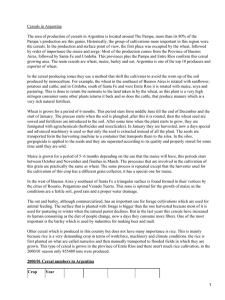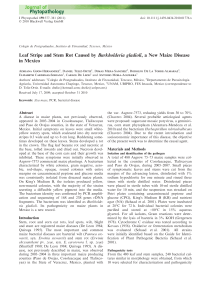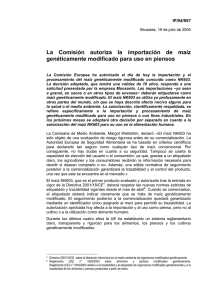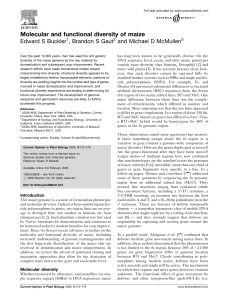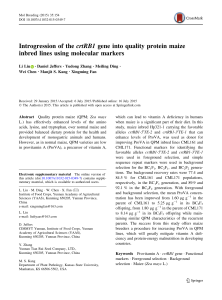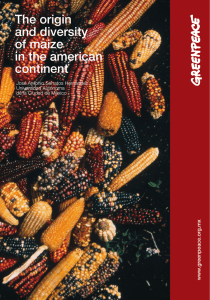Preceramic maize from Paredones and Huaca Prieta
Anuncio
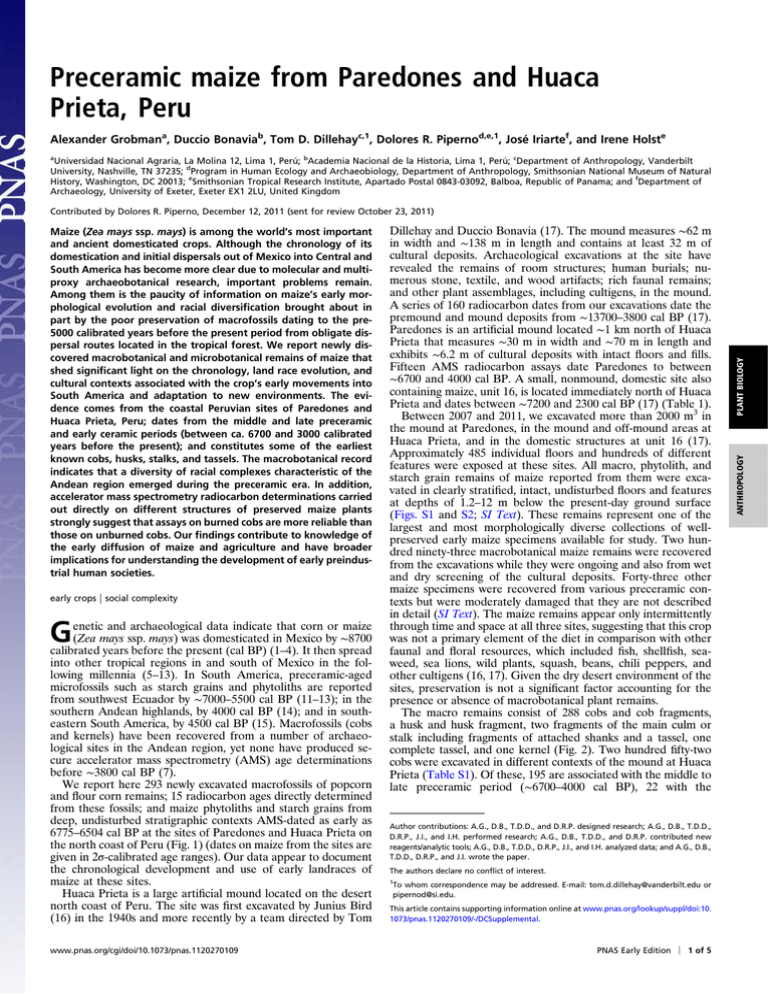
Preceramic maize from Paredones and Huaca Prieta, Peru Alexander Grobmana, Duccio Bonaviab, Tom D. Dillehayc,1, Dolores R. Pipernod,e,1, José Iriartef, and Irene Holste a Universidad Nacional Agraria, La Molina 12, Lima 1, Perú; bAcademia Nacional de la Historia, Lima 1, Perú; cDepartment of Anthropology, Vanderbilt University, Nashville, TN 37235; dProgram in Human Ecology and Archaeobiology, Department of Anthropology, Smithsonian National Museum of Natural History, Washington, DC 20013; eSmithsonian Tropical Research Institute, Apartado Postal 0843-03092, Balboa, Republic of Panama; and fDepartment of Archaeology, University of Exeter, Exeter EX1 2LU, United Kingdom early crops | social complexity G enetic and archaeological data indicate that corn or maize (Zea mays ssp. mays) was domesticated in Mexico by ∼8700 calibrated years before the present (cal BP) (1–4). It then spread into other tropical regions in and south of Mexico in the following millennia (5–13). In South America, preceramic-aged microfossils such as starch grains and phytoliths are reported from southwest Ecuador by ∼7000–5500 cal BP (11–13); in the southern Andean highlands, by 4000 cal BP (14); and in southeastern South America, by 4500 cal BP (15). Macrofossils (cobs and kernels) have been recovered from a number of archaeological sites in the Andean region, yet none have produced secure accelerator mass spectrometry (AMS) age determinations before ∼3800 cal BP (7). We report here 293 newly excavated macrofossils of popcorn and flour corn remains; 15 radiocarbon ages directly determined from these fossils; and maize phytoliths and starch grains from deep, undisturbed stratigraphic contexts AMS-dated as early as 6775–6504 cal BP at the sites of Paredones and Huaca Prieta on the north coast of Peru (Fig. 1) (dates on maize from the sites are given in 2σ-calibrated age ranges). Our data appear to document the chronological development and use of early landraces of maize at these sites. Huaca Prieta is a large artificial mound located on the desert north coast of Peru. The site was first excavated by Junius Bird (16) in the 1940s and more recently by a team directed by Tom www.pnas.org/cgi/doi/10.1073/pnas.1120270109 Dillehay and Duccio Bonavia (17). The mound measures ∼62 m in width and ∼138 m in length and contains at least 32 m of cultural deposits. Archaeological excavations at the site have revealed the remains of room structures; human burials; numerous stone, textile, and wood artifacts; rich faunal remains; and other plant assemblages, including cultigens, in the mound. A series of 160 radiocarbon dates from our excavations date the premound and mound deposits from ∼13700–3800 cal BP (17). Paredones is an artificial mound located ∼1 km north of Huaca Prieta that measures ∼30 m in width and ∼70 m in length and exhibits ∼6.2 m of cultural deposits with intact floors and fills. Fifteen AMS radiocarbon assays date Paredones to between ∼6700 and 4000 cal BP. A small, nonmound, domestic site also containing maize, unit 16, is located immediately north of Huaca Prieta and dates between ∼7200 and 2300 cal BP (17) (Table 1). Between 2007 and 2011, we excavated more than 2000 m3 in the mound at Paredones, in the mound and off-mound areas at Huaca Prieta, and in the domestic structures at unit 16 (17). Approximately 485 individual floors and hundreds of different features were exposed at these sites. All macro, phytolith, and starch grain remains of maize reported from them were excavated in clearly stratified, intact, undisturbed floors and features at depths of 1.2–12 m below the present-day ground surface (Figs. S1 and S2; SI Text). These remains represent one of the largest and most morphologically diverse collections of wellpreserved early maize specimens available for study. Two hundred ninety-three macrobotanical maize remains were recovered from the excavations while they were ongoing and also from wet and dry screening of the cultural deposits. Forty-three other maize specimens were recovered from various preceramic contexts but were moderately damaged that they are not described in detail (SI Text). The maize remains appear only intermittently through time and space at all three sites, suggesting that this crop was not a primary element of the diet in comparison with other faunal and floral resources, which included fish, shellfish, seaweed, sea lions, wild plants, squash, beans, chili peppers, and other cultigens (16, 17). Given the dry desert environment of the sites, preservation is not a significant factor accounting for the presence or absence of macrobotanical plant remains. The macro remains consist of 288 cobs and cob fragments, a husk and husk fragment, two fragments of the main culm or stalk including fragments of attached shanks and a tassel, one complete tassel, and one kernel (Fig. 2). Two hundred fifty-two cobs were excavated in different contexts of the mound at Huaca Prieta (Table S1). Of these, 195 are associated with the middle to late preceramic period (∼6700–4000 cal BP), 22 with the Author contributions: A.G., D.B., T.D.D., and D.R.P. designed research; A.G., D.B., T.D.D., D.R.P., J.I., and I.H. performed research; A.G., D.B., T.D.D., and D.R.P. contributed new reagents/analytic tools; A.G., D.B., T.D.D., D.R.P., J.I., and I.H. analyzed data; and A.G., D.B., T.D.D., D.R.P., and J.I. wrote the paper. The authors declare no conflict of interest. 1 To whom correspondence may be addressed. E-mail: [email protected] or [email protected]. This article contains supporting information online at www.pnas.org/lookup/suppl/doi:10. 1073/pnas.1120270109/-/DCSupplemental. PNAS Early Edition | 1 of 5 ANTHROPOLOGY Maize (Zea mays ssp. mays) is among the world’s most important and ancient domesticated crops. Although the chronology of its domestication and initial dispersals out of Mexico into Central and South America has become more clear due to molecular and multiproxy archaeobotanical research, important problems remain. Among them is the paucity of information on maize’s early morphological evolution and racial diversification brought about in part by the poor preservation of macrofossils dating to the pre5000 calibrated years before the present period from obligate dispersal routes located in the tropical forest. We report newly discovered macrobotanical and microbotanical remains of maize that shed significant light on the chronology, land race evolution, and cultural contexts associated with the crop’s early movements into South America and adaptation to new environments. The evidence comes from the coastal Peruvian sites of Paredones and Huaca Prieta, Peru; dates from the middle and late preceramic and early ceramic periods (between ca. 6700 and 3000 calibrated years before the present); and constitutes some of the earliest known cobs, husks, stalks, and tassels. The macrobotanical record indicates that a diversity of racial complexes characteristic of the Andean region emerged during the preceramic era. In addition, accelerator mass spectrometry radiocarbon determinations carried out directly on different structures of preserved maize plants strongly suggest that assays on burned cobs are more reliable than those on unburned cobs. Our findings contribute to knowledge of the early diffusion of maize and agriculture and have broader implications for understanding the development of early preindustrial human societies. PLANT BIOLOGY Contributed by Dolores R. Piperno, December 12, 2011 (sent for review October 23, 2011) Fig. 1. Location map of Paredones and Huaca Prieta, Peru. Cupisnique early ceramic period (∼4000–3000 cal BP), and 7 with the following Gallinazo ceramic period (∼2800–2300 cal BP) (Table 1 and Table S1). The frequency of cobs for certain races were identified by their morphology and by their kernel row numbers (Materials and Methods). Tables S2–S5 present cob length and width, glume, cupule, and other morphological characteristics. Fifteen AMS radiocarbon dates were obtained directly from various macromaize remains (Table 1). The dates provided mixed sets of determinations, some of which we consider to be valid and some anomalously young. Six of the radiocarbon dates on a husk, an articulated piece of a husk and charred shank, and burned cobs are stratigraphically consistent with 160 AMS dates on single pieces of wood charcoal and other burned material recovered from directly associated features in intact floors at these sites (17) (Table 1), providing a long, well-dated chronological sequence for the taxonomic identity and economic use of maize. Nine dates on five uncharred cobs are much younger than the AMS dates on associated features and floors and attached carbonized maize structures and appear to be in error (see below and SI Text for detailed discussion including possible sources of contamination). The valid dates resulted in calibrated ages ranging from ∼6700 to 3800 cal BP for the preceramic maize remains. A charred cob fragment from floor 6, at a depth of 1.2 m in unit 22 at Paredones, was dated to 4821–4527 cal BP (AA86934: Fig. S1). A fragment of husk attached to its partially charred shank from floor 18 (Fig. 3A), at a depth of 5.2 m in unit 22, provided an age of 6775–6504 cal BP (OS86020). This is the earliest assay obtained for maize at the three sites. However, four fragments of the same uncarbonized cob, attached to the dated fragment of husk articulated with its charred shank from floor 18, were measured at 722–563 (Beta27823), 729–569 (Beta27804), and 738–572 cal BP (Beta282127) and at a postbomb age of 1.0751 ± 0.0047 (AA88761), which is far too young and also internally inconsistent with other stratigraphically sequenced AMS dates on wood charcoal from unit 22 (Table 1). The discrepancy between the date on the husk/shank and those on the attached cob is striking. The δ13C value of –30.7 for the postbomb assay suggests a contaminant in the cob that is altering the age to be much younger than it should be. This value indicates that the carbon providing the date was largely not from maize but from another, younger source (see SI Text for further discussion). Another husk sample recovered from stratum 6b, at a depth of ∼2.2 m in the stratigraphically intact unit 20 at Paredones (Fig. 2A), was dated at 5582–5321 cal BP (AA86932), and two uncarbonized cob fragments from this same unit—one from stratum 5–6 at a depth of ∼2.0 m and another from stratum 6a at a depth of ∼2.1 m—were dated at 1055–831 cal BP (AA86938) and 1279–1076 cal BP (Beta263322), respectively. These two 2 of 5 | www.pnas.org/cgi/doi/10.1073/pnas.1120270109 younger dates are anomalous and rejected. Units HP-3 and 15/21 also produced acceptable and internally consistent dates on charred cobs at 4149–3839 cal BP (Beta278050) in stratum 28 (33) at a depth of ∼6.9 m in HP-3; at 3956–3704 cal BP (AA86941) in floor 2 at a depth of ∼1.5 m and at 4235–3928 cal BP (AA86946) in floor 9 at a depth of ∼2.8 m in unit 15/21. These three dates are internally consistent with other AMS dates in these units. It thus appears that the most reliable dates are for maize husks, shanks, and charred cobs, which have a more rigid, impenetrable plant structure. In assessing the radiocarbon dates directly on macromaize remains, the stratigraphically consistent 14 C dates obtained on directly associated wood charcoal, husks, and charred shanks and cobs should also be emphasized, as shown in Fig. S1 and Table 1 for unit 22. The cob from floor 18 in unit 22, whose fragment of husk attached to its charred shank is dated at 6775–6504 cal BP (OS86020), is 3.1 cm long, slender, and cylindrical; has eight rows of kernels; and can be identified as belonging to the Proto-Confite Morocho race (Fig. 3A). The number and size of cupules of this early maize suggests as many as 96 kernels (Tables S2–S3). The other cobs stratigraphically associated with the early part of the middle preceramic phase, ∼6700–5500 cal BP, are also from primitive popcorn races previously identified at other late preceramic sites in Peru (7–10) as Proto-Confite Morocho, Confite Chavinense (Fig. 3B and Table S1), and hybrid types between Proto-Confite Morocho and Confite Chavinense. The other ProtoConfite Morocho cobs of this period are 2.5–6.2 cm long, slender, and cylindrical with 8 rows of kernels, navicular cupules, and some 12 kernels per row. (See SI Text for more detailed information on the distribution of the various kinds of maize remains at the sites.) Samples dated to the later part of the middle preceramic phase between ∼5500 and 5000 cal BP included two stalks and a husk. On the basis of the length and size of the stalk fragments and husks, the late-middle-phase maize appears to have short plants perhaps no more than ∼1.5 m in height (Fig. 2D). The complete husk indicates a well-covered ear with a high venation index (Fig. 2A), resulting in high mechanical resistance to predatory feeding, perhaps by larvae of Helicoverpa zea, which are indirectly observed by punctures in husk leaves from other preceramic sites along the coast of Peru (10). Although the earliest maize cobs at Paredones and Huaca Prieta are predominantly of the eight-row Proto-Confite Morocho type, Confite Chavinense, a fasciated type of maize ear, is also present in the middle preceramic contexts and demonstrates evidence of hybridization with the race Proto-Confite Morocho (Tables S2–S5). These cobs of Confite Chavinense have two different diametrical axes; shortened, deeper cupules; and a higher number of rows; they have a clear association with present races from the coast such as Mochero and from the Andean highlands such as Huayleño, Granada, Paro, and Chullpi. Fasciation of the cob allows for a larger number of rows of kernels and could have been one of the early mechanisms of selection for higher grain yield. More productive races—identified by a higher number of kernel rows and more kernels in the row, achieved by fasciation first and length increase of the cob later—are found predominating in the later ceramic periods dated after ∼4000 cal BP in Peru (8). The races Proto-Kculli and Proto-Alazan appear in the final preceramic phase (see SI Text for further detail on the maize in this phase). Microfossil Results Study of fifty-four sediment samples from various floors and features at Paredones and Huaca Prieta and a cutting blade made of andesite revealed that both phytoliths and starch grains from maize occurred, although they did not occur in many contexts. The diagnostic phytoliths used to unequivocally identify maize occur in low frequency in maize cobs and are absent in some races, a factor that may in part account for their low numbers at the sites (Materials and Methods). Phytoliths definitively identified as maize were recovered from the 4.1- and Grobman et al. Provenience Unit 3 (Huaca Prieta) AA76977 Unit 3, floor 2 Beta233649 Unit 3, floor 3 AA76978 Unit 3, floor 5a AA76979 Unit 3, floor 5b Beta247695 Unit 3, stratum 8, below floor 6 Unit 16 Beta263319 Unit 16, floor 3 AA86935 Off-mound domestic unit 16, floor 13 Unit 20 (Paredones) AA86938 Unit 20, stratum 5–6 AA86936 Unit 20, stratum 5b Beta263322 Unit 20, stratum 6a AA86932 Unit 20, stratum 6b-18 AA86937 Unit 20, stratum 6b-18 Unit 15/21 (Huaca Prieta) AA86941 Unit 21, floor 2-3-16 AA86931 Unit 21, floor 3-2 AA86946 Unit 21, floor 9 AA75322 Unit 21, floor 26 AA85507 Unit 15, first mound layer Unit 22 (Paredones) AA86934 Unit 22, floor 6 Beta263988 Unit 22, floor 10 Beta263320 Unit 22, floor 10, capa 14 Beta263321 Unit 22, floor 15 AA86947 Unit 22, floor 16, fill 10 AA88761* Unit 22, floor 18-3 Beta27823* Unit 22, floor 18-3 Beta27804* Unit 22, floor 18-3 Beta282127* Unit 22, floor 18-3 OS86020* Unit 22, floor 18-3 AA83260 Unit 22, floor 24 Bird’s HP-3 (Huaca Prieta) AA81926 HP-3, stratum 5 AA86943 HP-3, stratum 14 AA86940 HP-3, stratum 19 AA81924 HP-3, stratum 22 AA81927 HP-3, stratum 23 Beta278050 HP-3, stratum 28(33) AA82121 HP-3, upper stratum 52 (39) AA81907 First mound layer: lower stratum 52–53 δ13C Conventional radiocarbon (yrs BP) 1σ-Calibrated age range (BP) 2σ-Calibrated age range (BP) Material ± ± ± ± ± −22.8 −10.2 −19.6 −19.6 −20.8 3530 1090 3567 3758 4000 36 40 40 40 40 3827–3693 973–911 3841–3717 4142–3978 4510–4296 3849–3636 1052–809 3901–3643 4216–3901 4520–4245 Wood charcoal Corn cob Wood charcoal Wood charcoal Organic sediment −11.7 −22.6 830 ± 40 6310 ± 33 728–678 7251–7162 767–664 7266–7021 Corn cob Wood charcoal −11.2 −23.8 −9.3 −23.5† −25.8 1130 4783 1310 4770 4849 ± ± ± ± ± 27 31 40 35 31 1051–936 5578–5330 1268–1143 5577–5321 5589–5479 1055–831 5583–5324 1279–1076 5582–5321 5603–5333 Corn cob Wood charcoal Corn cob Husk fragment Charred wood −10.6 −25.2 −11.9 −29.4 −25.6 3599 3638 3783 5018 6522 ± ± ± ± ± 29 29 41 86 54 3889–3728 3957–3838 4148–3988 5860–5599 7429–7323 3956–3704 3982–3728 4235–3928 5911–5488 7474–7268 Charred corn cob Wood charcoal Charred corn cob Wood charcoal Wood charcoal 4181 ± 34 105.4 ± 5 4590 ± 40 4790 ± 40 4898 ± 49 1.0751 ± 0.0047 (postbomb) 750 ± 40 770 ± 40 790 ± 40 5900 ± 40 5750 ± 60 4809–4570 132–44 5308–5062 5580–5331 5644–5483 — 4821–4527 133–34 5435–5044 5585–5325 5711–5335 — Charred corn cob Corn cob Charred material Charred material Wood charcoal Corn cob 679–571 720–578 721–662 6734–6569 6561–6405 722–563 729–569 738–572 6775–6504 6640–6319 Corn cob Corn cob Corn cob Husk and shank Wood charcoal ± ± ± ± ± ± ± ± 3634–3485 4213–3999 4287–4104 4063–3876 4084–3927 4087–3931 6789–6676 7154–6899 3688–3464 4233–3985 4406–4090 4084–3838 4147–3875 4149–3839 6882–6657 7162–6808 Wood charcoal Wood charcoal Wood charcoal Wood charcoal Wood charcoal Charred corn cob Cotton yarn Wood charcoal −13.4 — −24.5 −25.6 −24.0 −30.7 −9.8 −9.0 −9.2 −10.3 −26.0 −28.0 −24.6 −25.6 −23.5 −17.3 −14.9 — −23.8 3394 3806 3875 3687 3728 3740 5980 6170 40 28 30 40 40 40 40 45 *Dates processed on same integrated cob/shank/husk from floor 18. † Aberrant δ13C assay. All dates in Table 1 were calibrated using shcal04 (25). 5.2-m levels of unit TP-18 at Paredones, which 14C-dated between ∼6200 and 5800 cal BP (Fig. S3). Starch from maize kernels occurred in a sediment sample from unit 23 at Huaca Prieta and were 14C-dated to ∼5902–5606 cal BP. A total of seven starch grains with size and morphological attributes of maize (mean length: 18 μm; range of length: 10–24 μm) were isolated from this sample. Also, a 12.7-cm-long blade cutting tool made of andesite from floor 18, unit 22, at Paredones that was directly associated with four maize cobs of the Proto-Confite Morocho race yielded on one of its sharp lateral edges nine starch grains with morphologies like those of maize and with a mean length of 14 μm (range of length: 6–18 μm) (Figs. S4 and S5). The mean and maximum length of the grains is consistent with modern Latin American maize races, but because a few wild grasses contribute starch Grobman et al. grains that are large, the archaeological grains cannot be definitively identified as maize. Given their context, the grains are likely to be from maize, however (see SI Text for further detail on the tool and its use and wear characteristics). In their attributes, the starch grains from the sediments and cutting tool are consistent with grains found in hard endosperm varieties of maize, such as popcorns that were identified from the macrobotanical remains (3, 6, 12, 13). The maize kernel recovered from floor 18 of Paredones that dates to ∼5400 cal BP provided the opportunity to study starch grains directly from an ancient variety of popcorn. Starch grains occurred in substantial quantity from the sample removed from the kernel (Materials and Methods). Many grains were in clumps and could not be accurately measured. Measurements of a total of 23 grains yielded an average size of 19 μm (range: 12.8– PNAS Early Edition | 3 of 5 ANTHROPOLOGY Sample no. PLANT BIOLOGY Table 1. Radiocarbon dates on maize remains and wood charcoal from floors and features in excavated units at Paredones and Huaca Prieta Fig. 2. Various preceramic maize elements from the Paredones site. (A) Husk with high venation index. (B) Tassel showing no condensation, unlike tassels from most Mexican maize. (C) Popcorn grain. (D) Stalk internode from a slender plant, probably no taller than ∼1.5 m. 27 μm). In shape and surface features, the grains display the characteristic attributes of popcorn (e.g., with irregular polyhedral shapes, rough surfaces, and fissures) (6) (Fig. S6) and are like those previously recovered from archaeological stone tools and sediments from Mexico, Panama, and Ecuador that were identified as hard endosperm-popcorn types (3, 6, 12, 13). The infrequent occurrence of maize phytoliths could in part result from an occasional use of maize as a food source, as is also implied by the macrobotanical record. Because starch grains of any plant type were infrequent occurrences in most excavated deposits, it is probable that poor starch preservation as well as infrequent maize consumption accounts for the overall infrequency of maize starch in the three sites. We found no archaeological evidence such as drinking cups, boiling vessels, and storage bins to suggest that maize was used as a fermentable drink in late preceramic times, as suggested by some investigators (18, 19). Discussion The archaeological macroremains from Paredones and Huaca Prieta attest to a long and diverse history of maize in the northern Peruvian Andean region that can be traced to at least 6775–6504 cal BP, with an early development of distinct maize racial groupings in that region. This is the oldest AMS date on maize macrofossils from South America and shows that the earliest maize at the sites is roughly contemporary in age with the earliest macrofossil remains of maize currently recorded from Mexico, which are the cobs from Guila Naquitz Cave that were directly dated to ca. 6200 cal BP (20). Our study also provides collections of both macrofossils and microfossils of pre-5000 cal BP maize in the Americas. The 6775–6504 cal BP date is in accord with the presence of archaeological maize starch grains and phytoliths in central Panama at ∼7600 cal BP (6) and maize phytoliths in southwest Ecuador by ∼7000 cal BP (11). On the basis of our results, the early Peruvian maize was a popcorn type in seed size, hardness, and popping ability. Interestingly, the Fig. 3. Races of preceramic maize cobs from Paredones and Huaca Prieta. (A) Proto-Confite Morocho cob with large soft glumes; the extreme lower right tip of the cob shows the remainder of a partially charred shank fragment (arrow), a portion of which with its attached husk fragment was removed and AMS dated to 6775–6504 cal BP. (B) Confite Chavinense cob exhibiting fasciation and cupules underlying very small kernels. (C) Proto-Alazan cob. 4 of 5 | www.pnas.org/cgi/doi/10.1073/pnas.1120270109 Grobman et al. Materials and Methods Macrobotanical Maize Remains. All complete cobs and cob fragments, stalks, and husk leaves were studied under low-power magnification from each excavation unit at Paredones, Huaca Prieta, and unit 16. The morphological 1. van Heerwaarden J, et al. (2011) Genetic signals of origin, spread, and introgression in a large sample of maize landraces. Proc Natl Acad Sci USA 108:1088–1092. 2. Matsuoka Y, et al. (2002) A single domestication for maize shown by multilocus microsatellite genotyping. Proc Natl Acad Sci USA 99:6080–6084. 3. Piperno DR, Ranere AJ, Holst I, Iriarte J, Dickau R (2009) Starch grain and phytolith evidence for early ninth millennium B.P. maize from the Central Balsas River Valley, Mexico. Proc Natl Acad Sci USA 106:5019–5024. 4. Ranere AJ, Piperno DR, Holst I, Dickau R, Iriarte J (2009) Preceramic human occupation of the Central Balsas Valley, Mexico: Cultural context of early domesticated maize and squash. Proc Natl Acad Sci USA 106:5014–5018. 5. Pohl MED, Piperno DR, Pope KO, Jones JG (2007) Microfossil evidence for pre-Columbian maize dispersals in the neotropics from San Andres, Tabasco, Mexico. Proc Natl Acad Sci USA 104:6870–6875. 6. Piperno DR, Ranere AJ, Holst I, Hansell P (2000) Starch grains reveal early root crop horticulture in the Panamanian tropical forest. Nature 407:894–897. 7. Bonavia D (2008) El Maiz (Univ. San Martin de Porres, Fondo Editorial, Lima, Peru). 8. Grobman A, Salhuana W, Sevilla R, Mangelsdorf PC (1961) Races of Maize in Peru (National Academy of Sciences and National Research Council, Pub. 915, Washington, DC). 9. Bonavia D (1982) Precerámico Peruano, Los Gavilanes: Mar, Desierto y Oasis en la Historia del Hombre (Corp. Finan. Desarrollo S.A. COFIDE, Instituto Arqueológico Alemán, Lima, Peru). 10. Grobman A (1982) Mays (Zea mays). Precerámico Peruano, Los Gavilanes: Mar, Desierto y Oasis en la Historia del Hombre, ed Bonavia D (Corp. Finan. Desarrollo S.A. COFIDE, Instituto Arqueológico Alemán, Lima, Peru), pp 157–180. 11. Piperno DR (2006) Phytolith Analysis: A Comprehensive Guide for Archaeologists and Paleoecologists (Alta Mira Press, Lanham, MD). 12. Zarrillo S, Pearsall DM, Raymond JS, Tisdale MA, Quon DJ (2008) Directly dated starch residues document early formative maize (Zea mays L.) in tropical Ecuador. Proc Natl Acad Sci USA 105:5006–5011. Grobman et al. Phytoliths and Starch Grains. Phytolith extractions from the archaeological sediments followed standard procedures (11). Extended counts were carried out to search for wavy-top maize rondel types, which constitute a minor part of the prolific rondel assemblages produced by maize cobs and may be absent in some maize races (11). Other phytoliths consistent with maize cob decay were present in other excavation units but could not be definitively identified. Phytolith identifications were based on a modern reference collection of more than 750 specimens including major South American crops and their closest wild relatives housed at the Archaeobotany Laboratory, Department of Archeology, University of Exeter (Exeter, United Kingdom). Starch grain analysis of sediments and the stone tool followed standard procedures (3, 6). The maize kernel was sampled by inserting a thin needle through the outer layer into the endosperm, removing the needle, and then washing it with water in a plastic container to collect the adhering residue. The residue was mounted directly in water on a microscope slide. Archaeological starch grains were compared with a modern reference collection consisting of about 500 species of neotropical plants, including 24 traditional maize races from Central and South America. It has been shown through extensive studies of wild neotropical grasses, including taxa native to coastal northwestern South America, that a combination of morphological and size criteria can securely separate the starch grains of neotropical grasses from maize (3, 6, 12, 24). ACKNOWLEDGMENTS. We thank two reviewers for their helpful comments on the manuscript and the Ministerio de Cultura, Lima, Peru, for granting us the permission to work at Huaca Prieta and Paredones. We are grateful to Cesar Galvéz and Jesus Briceño (Dirección Regional del Ministerio de la Cultura, Trujillo) for their support. Additional support was provided by the Lapinski and O’Leary families. We thank Tim Messner for assistance with the starch grain study and Sandra Manrique for photographing the maize phytolith remains. The authors are grateful to the Department of Anthropology at the American Museum of Natural History for granting permission to study Junius Bird’s notes and photographs from Huaca Prieta, as well as the artifacts that he recovered from the site. Financial support for this project came from the National Science Foundation, the National Geographic Society, Vanderbilt University, the Smithsonian National Museum of Natural History, and the Smithsonian Tropical Research Institute. 13. Pearsall DM, Chandler-Ezell K, Chandler-Ezell A (2004) Maize in ancient Ecuador: Results of residue analysis of stone tools from the Real Alto site. J Archaeol Sci 31:423–442. 14. Perry L, et al. (2006) Early maize agriculture and interzonal interaction in southern Peru. Nature 440(7080):76–79. 15. Iriarte J, et al. (2004) Evidence for cultivar adoption and emerging complexity during the mid-Holocene in the La Plata basin. Nature 432:614–617. 16. Bird JB, Hyslop J, Skinner MD (1985) Huaca Prieta: A Preceramic Site in Northern Peru (Anthropological Papers of the American Museum of Natural History, New York). 17. Dillehay TD, et al. (2011) Coastal environment and cultural complexity at Huaca Prieta, Peru from 9000 to 4500 years ago. Antiquity, in press. 18. Iltis HH (2000) Homeotic sexual translocations and the origin of maize (Zea mays Poaceae): A new look at an old problem. Econ Bot 54(1):7–42. 19. Smalley J, Blake M (2003) Sweet beginnings: Stalk sugar and the domestication of maize. Curr Anthropol 44:675–703. 20. Piperno DR, Flannery KV (2001) The earliest archaeological maize (Zea mays L.) from highland Mexico: New accelerator mass spectrometry dates and their implications. Proc Natl Acad Sci USA 98:2101–2103. 21. Benz BF (2001) Archaeological evidence of teosinte domestication from Guilá Naquitz, Oaxaca. Proc Natl Acad Sci USA 98:2104–2106. 22. Cutler HH (1946) Races of maize in South America. Bot Mus Leaflets 12:257–291. 23. Nickerson NH (1953) Variation in cob morphology among certain archaeological and ethnological races of maize. Ann Mo Bot Gard 40(1):79–111. 24. Holst I, Moreno JE, Piperno DR (2007) Identification of teosinte, maize, and Tripsacum in Mesoamerica by using pollen, starch grains, and phytoliths. Proc Natl Acad Sci USA 104:17608–17613. 25. McCormac FG, et al. (2004) SHCal04 Southern Hemisphere Calibration 0 - 11.0 cal kyr BP. Radiocarbon 46:1087–1092. PNAS Early Edition | 5 of 5 PLANT BIOLOGY characteristics of the cobs were identified from previously defined pre-Hispanic races of maize (8) and from maize remains from other preceramic sites (7). The external measurements of cob length, cob diameter, and cob pith were measured directly. Although Huaca Prieta is located in an arid setting, some cobs were in only fair condition due to the humidity and high water tables found in the ocean beachline setting. This prevented determination of the diameter of the rachis in these specimens. Therefore, the ratio of the cob-to-pith diameters was used instead of the index cob/rachis (8). We also measured the average linear means and weighted means and adjusted for the number of cobs of each type. The characteristics of the glumes, cupules, and cupule hairs were also defined. Examination of the cupule characteristics was made with procedures established by previous studies (8, 22, 23). ANTHROPOLOGY early Peruvian maize described here is different in some significant respects from the nearly contemporaneous earliest specimens from the Guila Naquitz Cave (20, 21), suggesting that maize may have undergone important developments when it left Mexico. For example, the Peruvian specimens all lack indurated and extended lower glumes, have paired spikelets, nearly twice the number of rows, and are polystichous and slightly longer. These features selected by human cultivators resulted in increased seed yield and made kernels easier to remove from chaff and turn into food. The cobs do not exhibit the bilaterally symmetrical distichous inflorescences found in Guilá Naquitz cobs, which exhibit strong teosinte influence (21). Grobman (10) has found no teosinte traits in coastal Peruvian maize, including the Huaca Prieta and Paradones specimens. It should probably not be assumed that maize was developed in the same ways or at the same times by different cultures after it was dispersed out of Mexico or even in Mexico during earlier periods in its evolution. It is possible, for example, that when hybridization with teosinte could not occur, improvements in maize productivity were easier for prehistoric farmers to achieve. Continuing the search for and recovery of early macrofossils will expand our limited knowledge of the morphological evolution of maize into the traditional landraces still grown by many farmers in Latin America today. This study also indicates that re-excavation of sites along the arid Peruvian coast first studied many years ago, along with searches for habitation sites not previously explored, may provide a substantial amount of information in that regard. Our data also importantly show that two primitive Andean landraces, Proto-Confite Morocho and Confite Chavinense, are present during all preceramic phases at Paredones and Huaca Prieta, although their relative frequencies change. These data agree with previous findings at other late preceramic sites along the coast of Peru (7–10). Given the scarcity and discontinuous stratigraphic presence of maize macrofossils and microfossils at Paredones and Huaca Prieta and at other preceramic sites in the region (10), we infer that this crop, in both its popcorn and floury forms, was not a primary food staple in the local diet before ∼4500–4200 cal BP. With more evidence in the future, the complex social, environmental, and technological trajectories of maize dispersion and development in South America will be better understood.
